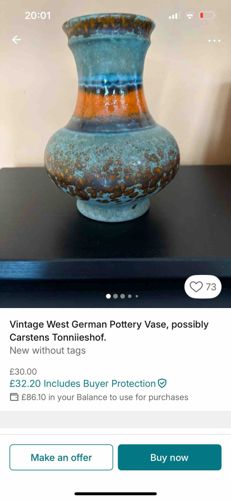
Vintage West German Fat Lava Pottery Vase
This is a vintage West German pottery vase, possibly manufactured by Carstens Tönnieshof, based on the seller's description. The vase exhibits a distinctive Fat Lava glaze, characterized by its textured, almost volcanic surface, particularly noticeable on the lower and upper sections. The primary color palette features shades of turquoise/teal and brown, with a prominent horizontal band of vibrant orange and dark blue/indigo around its mid-section. The form is classic, with a bulbous base that tapers inward towards a narrower neck and then flares slightly outwards at the rim. The bottom appears to have a small, defined foot. The craftsmanship suggests a handmade or semi-handmade process, typical of mid-century studio pottery or art pottery. There are no visible chips, cracks, or significant damage from the provided images, indicating good overall condition, consistent with 'new without tags' or lightly used vintage item. The glaze shows variations in texture and color saturation, which is inherent to this type of glazing technique and adds to its aesthetic appeal. The mottled, crater-like texture gives it a unique tactile quality. The style is indicative of West German pottery from the mid-20th century, likely 1960s or 1970s, a period renowned for its innovative glazes and forms.
AI-Generated Appraisal Disclaimer
Estimated Value
$175-225
Basic Information
Category
Pottery
Appraised On
December 7, 2025
Estimated Value
$175-225
Item Description
This is a vintage West German pottery vase, possibly manufactured by Carstens Tönnieshof, based on the seller's description. The vase exhibits a distinctive Fat Lava glaze, characterized by its textured, almost volcanic surface, particularly noticeable on the lower and upper sections. The primary color palette features shades of turquoise/teal and brown, with a prominent horizontal band of vibrant orange and dark blue/indigo around its mid-section. The form is classic, with a bulbous base that tapers inward towards a narrower neck and then flares slightly outwards at the rim. The bottom appears to have a small, defined foot. The craftsmanship suggests a handmade or semi-handmade process, typical of mid-century studio pottery or art pottery. There are no visible chips, cracks, or significant damage from the provided images, indicating good overall condition, consistent with 'new without tags' or lightly used vintage item. The glaze shows variations in texture and color saturation, which is inherent to this type of glazing technique and adds to its aesthetic appeal. The mottled, crater-like texture gives it a unique tactile quality. The style is indicative of West German pottery from the mid-20th century, likely 1960s or 1970s, a period renowned for its innovative glazes and forms.
Related Tags
Get Your Items Appraised
Instant estimates of your treasures with AI-powered instant appraisals